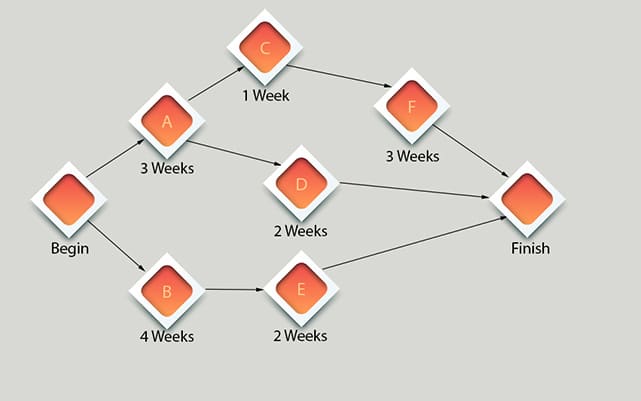CPM Chart

CPM Chart – Project Planning and Time Analysis
We belong to a big organization. We are project managers. No doubt, we have many projects in our hands. We have all the necessary resources at our disposal. As usual, there is a pressure to complete the projects on time, which obviously we don’t have in spare. We try hard. We bring all the resources in action. Still we see that we are lagging far behind the schedule. And we become desperate.
Only thing that helps us in this situation is the guidance from the CPM chart of the project, if we’ve created one. It’s like a friend in need. At the critical stage, it shows us the way and leads us to the path of success.
In such a case, planning of the project and its implementation as per the pre-planned schedule makes our job easier. That’s why more and more project managers nowadays rely upon the CPM charting and time analysis.
CPM as a management concept isn’t new anymore. It has been in practice since 1950s. CPM or the Critical Path Method actually is a project planning technique used in most organizations to chalk out proper schedule of the projects. CPA is its Critical Path Analysis.
These are the most valuable tools for the project planners, which help the managers to track the progress of the ongoing project, anticipate delays or hasten the processes to complete the work on time.
Project planning and time management are major responsibilities of the project managers. Projects can be completed on time if planned properly through the CPM. Using mathematical calculations, the CPM chart can be created and schedule of all the activities can be planned and fixed as per the requirements of the project.
There are steps involved in the planning and proper execution of these projects. The list given below may help the managers to frame a schedule for timely completion of their projects.
 Resultant CPM Chart
Resultant CPM Chart
The resultant CPM chart may also help them to analyze the time consumed by every task as per the requirement at each phase of the project. Let’s have a look.
- List all the tasks and activities required for the project before its launch.
- Make their sequence in a network depending upon individual priority, importance and duration needed for the project completion.
- Assign time schedule to each task, allot start date, and end date that you may think feasible for each activity of the project.
- Create a CPM chart marking every scheduled activity clearly marked in the network..
- Chalk out the longest duration path through this network. This is your critical path. If any activity belonging to this path is delayed for any reason, there is always a possibility of delay in the completion of the project. It may end late consuming more budget than planned.
- Keep a timely update of all these activities on the chart. Focus should be on the activities placed in the critical path. If a task seems running late, accelerate it by employing additional resources. You can also add a few more supplementary tasks to boost the time line, if needed.
The CPM chart shows time bound activities in the critical path. It is the longest duration work in the project. This path brings to the notice of the managers those tasks that are to be prioritized and completed on time, how much work is remaining and which task is lagging behind.
Tasks that are non-critical may still require careful management. But the critical path forewarns them of delays if any out of the performance of these tasks, which may delay the entire project. Most of the times, if such delay is noticed, the activities in the critical path line can be accelerated or re-scheduled to meet the project deadline.
Therefore, it’s always better to use the CPM charting technique to plan and analyze a project’s time duration. Critical path identification is done at the planning phase of the project itself. This gives the project management right choice of priority activities and estimated date of the project completion. It also gives the managers maneuverability and flexibility to implement their plan in action for successful completion of the project as per the planned schedule.
